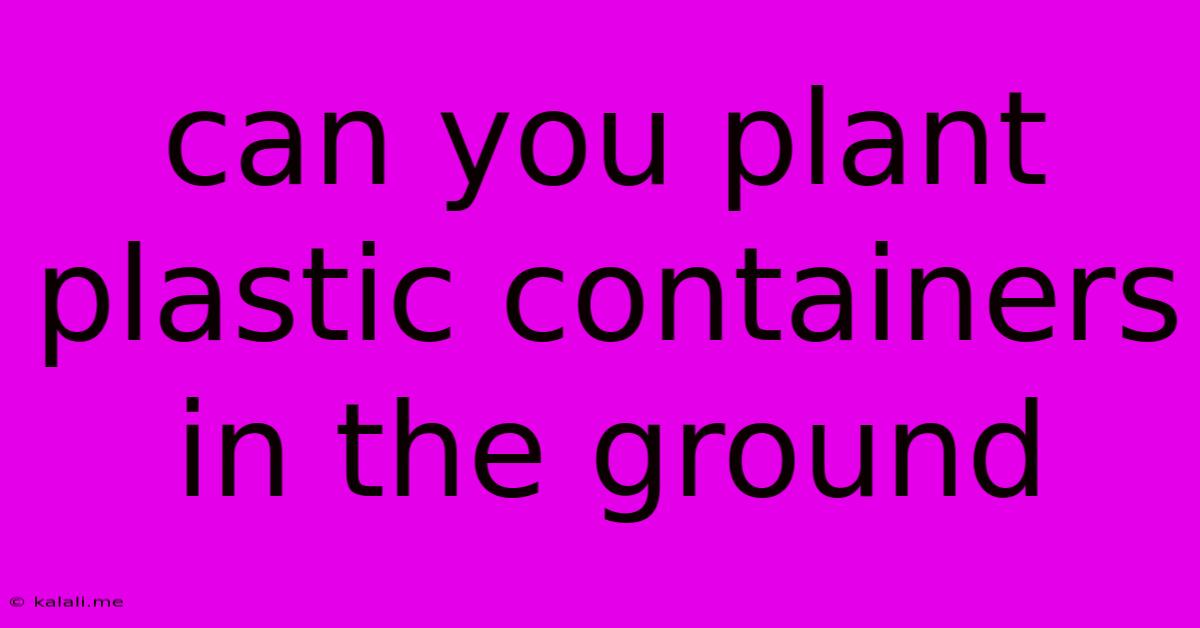Can You Plant Plastic Containers In The Ground
Kalali
Jun 02, 2025 · 3 min read

Table of Contents
Can You Plant Directly in Plastic Containers? A Deep Dive into Garden Sustainability
So, you've got a bunch of plastic containers – leftover takeout tubs, yogurt pots, margarine containers – and you're wondering: can I just bury these and plant directly into them? It seems like a convenient way to get your seedlings in the ground, reducing waste and potentially boosting drainage. But the answer, unfortunately, isn't a simple yes or no. Let's delve into the pros, cons, and sustainable alternatives.
The Allure of Repurposing Plastic Containers for Planting:
Repurposing plastic containers for planting taps into a growing awareness of environmental sustainability. Reducing landfill waste is crucial, and using existing materials seems like a logical step toward a greener garden. Plus, some plastic containers, particularly those with drainage holes, might seem like a quick and easy solution for planting seeds or seedlings, especially for smaller plants.
Why Directly Planting in Plastic Containers Might Not Be Ideal:
While the intention is good, there are several significant drawbacks to burying plastic containers directly in the ground for planting:
- Decomposition: Most plastics used for food packaging are not biodegradable. They will persist in the soil for hundreds, even thousands of years, contributing to plastic pollution in the environment. This contaminates your soil and can negatively impact plant growth in the long run.
- Root Restriction: Plastic is a rigid material that restricts root growth. Your plants' roots won't be able to penetrate the container walls and explore the surrounding soil for nutrients and water as effectively as they would with biodegradable alternatives. This can lead to stunted growth and weaker plants.
- Chemical Leaching: Some plastics can leach harmful chemicals into the soil, potentially affecting plant health and even contaminating the food you grow. This is particularly concerning for food-grade containers that might contain BPA or other potentially harmful substances.
- Soil Disruption: Removing the plastic containers later, if you ever decide to do so, can disrupt the soil structure and damage existing plant roots. This is a particularly significant issue if you're trying to maintain a healthy, thriving garden ecosystem.
Sustainable Alternatives for Planting:
Fortunately, there are many eco-friendly alternatives to using plastic containers for planting:
- Biodegradable Pots: These pots are made from materials like peat moss, coconut coir, or recycled paper pulp. They decompose naturally in the soil, enriching it and providing valuable nutrients to your plants.
- Paper Cups or Cardboard Pots: These are easily available and decompose readily, although you may want to ensure they're not treated with wax or other coatings that won’t break down.
- DIY Seed Starters from Recycled Materials: Get creative and use readily available, biodegradable materials like egg cartons, newspaper, or even repurposed fabric scraps to create your own seed starters.
- Direct Sowing: For many plants, directly sowing seeds into the prepared garden bed is the easiest and most environmentally friendly method.
Conclusion:
While the desire to repurpose plastic containers for planting stems from a good place – a commitment to environmental responsibility – the reality is that it's not a sustainable practice. The negative impact on soil health, plant growth, and the environment outweighs any perceived convenience. Opting for biodegradable alternatives or direct sowing is a much better choice for both your garden and the planet. Remember, responsible gardening practices contribute to a healthy ecosystem and sustainable future.
Latest Posts
Latest Posts
-
Legends Of The Fall Where Filmed
Jun 04, 2025
-
How To Know If A Sponge Has Gone Moldy
Jun 04, 2025
-
Store Frequently Used Data Logins Addresses
Jun 04, 2025
-
How To Make A Pocket Hole Jig
Jun 04, 2025
-
Term For The People Served By A Nonprofit
Jun 04, 2025
Related Post
Thank you for visiting our website which covers about Can You Plant Plastic Containers In The Ground . We hope the information provided has been useful to you. Feel free to contact us if you have any questions or need further assistance. See you next time and don't miss to bookmark.